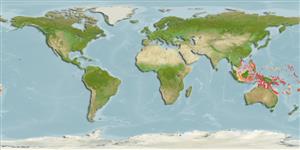>
Gobiiformes (Gobies) >
Gobiidae (Gobies) > Gobiinae
Etymology: Signigobius: Name from Latin, signus for mark and gobius for a genus of fish, referring to its distinctive coloration.; biocellatus: Name from Latin bi meaning two and ocellatus for small eye spots, referring to the 2 prominent ocellated spots on the dorsal fins..
More on authors: Hoese & Allen.
Environment: milieu / climate zone / depth range / distribution range
экология
морской ассоциированный с рифами; пределы глубины 1 - 30 m (Ref. 1602), usually 2 - 30 m (Ref. 27115). Tropical; 22°C - 27°C (Ref. 27115); 19°N - 24°S
Western Pacific: Philippines to the Solomon Islands and Vanuatu, south to the southern Great Barrier Reef; Palau in Micronesia.
Size / Вес / Возраст
Maturity: Lm ? range ? - ? cm
Max length : 10.0 cm SL самец/пол неопределен; (Ref. 48637)
колючие лучи спинного плавника (общее число): 7; членистые (мягкие) лучи спинного плавника (общее число): 10-11; колючие лучи анального плавника 1; членистые (мягкие) лучи анального плавника: 10 - 11. Conspicuous ocellated dorsal fins (Ref. 90102); characterized by pale bluish grey to yellowish tan; narrow brown bar below eye; upper half of body with irregular brown spot and saddles; three irregular brown bars on lower half of body; narrow brown bar across base of caudal fin; pelvic and anal fins black with blue spots; rounded caudal fin; longitudinal scale series 48-55; mainly ctenoid body scales posteriorly, becoming cycloid anteriorly just behind pectoral base and below first dorsal fin; cycloid on ventral surface of abdomen; head and midline of nape without scales; depth of body 4.3-5.6 in SL (Ref. 90102).
Adults occur in sandy to silty bottoms of lagoons and coastal bays near coral, rubble or leaf litter shelter. Solitary or in pairs that share sandy burrows (Ref. 90102). Feed on small interstitial invertebrates by sifting mouthfuls of sand. Monogamous (Ref. 52884, 48637).
Life cycle and mating behavior
половая зрелость | размножение | нерест | икра | Fecundity | личинки
Monogamous mating is observed as both obligate and social (Ref. 52884).
Allen, G.R. and R. Swainston, 1992. Reef fishes of New Guinea: a field guide for divers, anglers and naturalists. Publication No. 8. Christensen Research Institute, Madang, Papua New Guinea. 132 p. (Ref. 6023)
Статус Красного Списка МСОП (Ref. 130435)
Угроза для людей
Harmless
Использование человеком
рыболовство: интереса не представляет; аквариум: коммерческий
дополнительная информация
ссылкиаквакультура (рыбоводство)особенности рыбоводствастепень растяжениягенетикаElectrophoresesнаследуемостьболезниобработкаNutrientsMass conversion
инструменты
Специальные отчеты
Скачать в формате XML
ресурсы в Интернет
Estimates based on models
Preferred temperature (Ref.
123201): 25.8 - 28.9, mean 27.7 °C (based on 350 cells).
Phylogenetic diversity index (Ref.
82804): PD
50 = 1.0000 [Uniqueness, from 0.5 = low to 2.0 = high].
Bayesian length-weight: a=0.01023 (0.00477 - 0.02194), b=3.02 (2.84 - 3.20), in cm total length, based on LWR estimates for this (Sub)family-body shape (Ref.
93245).
Trophic level (Ref.
69278): 3.5 ±0.37 se; based on food items.
устойчивость к внешним воздействиям (Ref.
120179): высокий, минимальное время удвоения популяции до 15 месяцев (Preliminary K or Fecundity.).
Fishing Vulnerability (Ref.
59153): Low vulnerability (10 of 100).
Nutrients (Ref.
124155): Calcium = 108 [58, 218] mg/100g; Iron = 0.771 [0.403, 1.406] mg/100g; Protein = 18.5 [16.7, 20.2] %; Omega3 = 0.157 [0.071, 0.270] g/100g; Selenium = 21.2 [11.4, 41.4] μg/100g; VitaminA = 149 [43, 452] μg/100g; Zinc = 1.79 [1.21, 2.64] mg/100g (wet weight);
